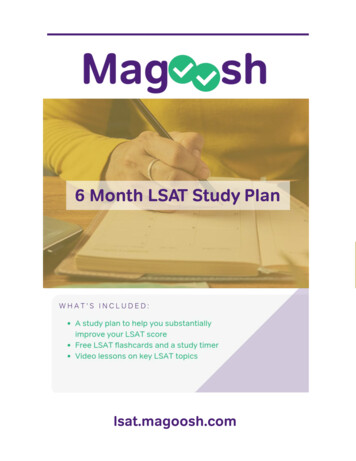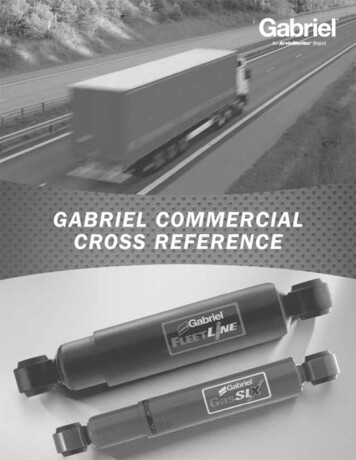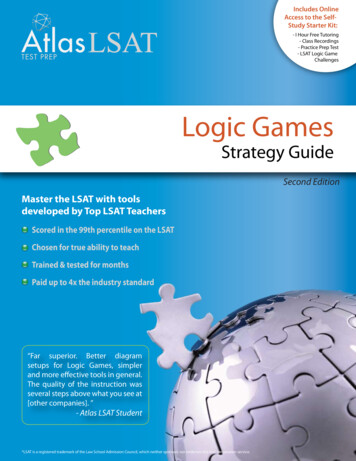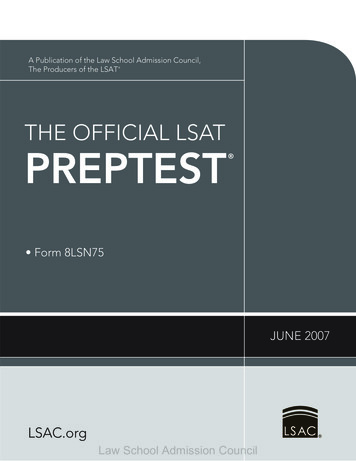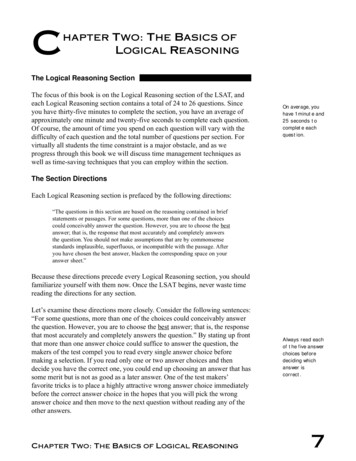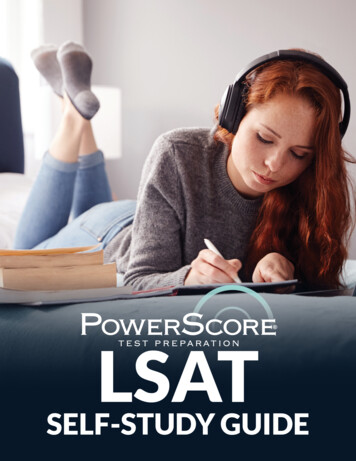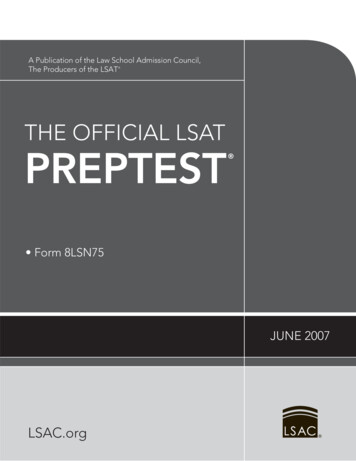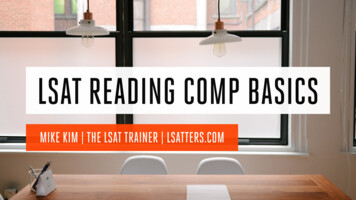
Transcription
LSAT READING COMP BASICSMIKE KIM THE LSAT TRAINER LSATTERS.COM
A Lesson On LSAT Reading ComprehensionWith Mike Kim, Author Of The LSAT Trainer
http://lsatters.com/lsat-reading-compPassage 3, Pages 26 - 27 (Pages 27 - 28 in PDF)
The World Wide Web, a network of electronically produced andinterconnected (or “linked”) sites, called pages, that are accessible viapersonal computer, raises legal issues about the rights of owners ofintellectual property, notably those who create documents forinclusion on Web pages. Some of these owners of intellectual propertyclaim that unless copyright law is strengthened, intellectual propertyon the Web will not be protected from copyright infringement. Webusers, however, claim that if their ability to access information on Webpages is reduced, the Web cannot live up to its potential as an open,interactive medium of communication.The debate arises from the Web’s ability to link one document toanother. Links between sites are analogous to the inclusion in a printedtext of references to other works, but with one difference: the citeddocument is instantly retrievable by a user who activates the link. Thisimmediate accessibility creates a problem, since current copyrightlaws give owners of intellectual property the right to sue a distributorof unauthorized copies of their material even if that distributor did notpersonally make the copies. If person A, the author of a document,puts the document on a Web page, and person B, the creator ofanother Web page, creates a link to A’s document, is B committingcopyright infringement?To answer this question, it must first be determined who controlsdistribution of a document on the Web. When A places a document ona Web page, this is comparable to recording an outgoing message onone’s telephone answering machine for others to hear. When B createsa link to A’s document, this is akin to B’s giving out A’s telephonenumber, thereby allowing third parties to hear the outgoing messagefor themselves. Anyone who calls can listen to the message; that is itspurpose. While B’s link may indeed facilitate access to A’s document,the crucial point is that A, simply by placing that document on theWeb, is thereby offering it for distribution. Therefore, even if B leadsothers to the document, it is A who actually controls access to it.Hence creating a link to a document is not the same as making ordistributing a copy of that document. Moreover, techniques arealready available by which A can restrict access to a document. Forexample, A may require a password to gain entry to A’s Web page,just as a telephone owner can request an unlisted number and discloseit only to selected parties. Such a solution would compromise theopenness of the Web somewhat, but not as much as the threat ofcopyright infringement litigation. Changing copyright law to benefitowners of intellectual property is thus ill-advised because it wouldimpede the development of the Web as a public forum dedicated tothe free exchange of ideas.June, 2007 Exam, Section 4
15. Which one of the following most accurately expresses the main point of the passage?(A) Since distribution of a document placed on a Web page is controlled by the author of that page rather than bythe person who creates a link to the page, creating such a link should not be considered copyright infringement.(B) Changes in copyright law in response to the development of Web pages and links are ill-advised unless suchchanges amplify rather than restrict the free exchange of ideas necessary in a democracy.(C) People who are concerned about the access others may have to the Web documents they create can easilyprevent such access without inhibiting the rights of others to exchange ideas freely.(D) Problems concerning intellectual property rights created by new forms of electronic media are not insuperablydifficult to resolve if one applies basic commonsense principles to these problems.(E) Maintaining a free exchange of ideas on the Web offers benefits that far outweigh those that might be gainedby a small number of individuals if a radical alteration of copyright laws aimed at restricting the Web’s growthwere allowed.
17. With which one of the following claims about documents placed on Web pages would the author be mostlikely to agree?(A) Such documents cannot receive adequate protection unless current copyright laws are strengthened.(B) Such documents cannot be protected from unauthorized distribution without significantly diminishingthe potential of the Web to be a widely used form of communication.(C) The nearly instantaneous access afforded by the Web makes it impossible in practice to limit access tosuch documents.(D) Such documents can be protected from copyright infringement with the least damage to the publicinterest only by altering existing legal codes.(E) Such documents cannot fully contribute to the Web’s free exchange of ideas unless their authors allowthem to be freely accessed by those who wish to do so.
21. The author’s discussion of telephone answering machines serves primarily to(A) compare and contrast the legal problems created by two different sorts of electronic media(B) provide an analogy to illustrate the positions taken by each of the two sides in the copyrightdebate(C) show that the legal problems produced by new communication technology are notthemselves new(D) illustrate the basic principle the author believes should help determine the outcome of thecopyright debate(E) show that telephone use also raises concerns about copyright infringement
http://lsatters.com/lsat-reading-compPassage 4, Pages 26 - 27 (Pages 27 - 28 in PDF)
What does the LSAT test?Reasoning AbilityReading AbilityMental Discipline
What does the LSAT test?Reasoning AbilityReading AbilityMental Disciplinemost important forReading Comp
Reading AbilityUnderstand theexact meaning ofwordsRecognize reasoningstructure
How to think about reasoning structureThe way in which an author has structured a passage to serveits intended purpose.
How to think about reasoning structure- relationship between parts of a passage- role played by each part of the passage- reason why the author mentions things
Why is Reasoning Structure so important?It’s what the questions are about.
- Tendencies & Twists -discusses one-sided issueoffers no author opinionThe Typical LSAT Passagediscusses a two-sided issuetries to give you the relevant contextoffers an author opinionoffers a complex authoropiniondiscusses a three-sided issueand so on
Basic Reading Strategy SuggestionsFocus on reasoning structure.Why? Why, Why?Don’t try to do too much at once.Assess between paragraphs.Not a memorization test.Review. Reassess. Anticipate.Assess when you are done reading.It’s the best time to do so.Use questions to critique your understanding.Reassess if necessary.
The World Wide Web, a network of electronically produced andinterconnected (or “linked”) sites, called pages, that are accessible viapersonal computer, raises legal issues about the rights of owners ofintellectual property, notably those who create documents forinclusion on Web pages. Some of these owners of intellectual propertyclaim that unless copyright law is strengthened, intellectual propertyon the Web will not be protected from copyright infringement. Webusers, however, claim that if their ability to access information on Webpages is reduced, the Web cannot live up to its potential as an open,interactive medium of communication.The debate arises from the Web’s ability to link one document toanother. Links between sites are analogous to the inclusion in a printedtext of references to other works, but with one difference: the citeddocument is instantly retrievable by a user who activates the link. Thisimmediate accessibility creates a problem, since current copyrightlaws give owners of intellectual property the right to sue a distributorof unauthorized copies of their material even if that distributor did notpersonally make the copies. If person A, the author of a document,puts the document on a Web page, and person B, the creator ofanother Web page, creates a link to A’s document, is B committingcopyright infringement?To answer this question, it must first be determined who controlsdistribution of a document on the Web. When A places a document ona Web page, this is comparable to recording an outgoing message onone’s telephone answering machine for others to hear. When B createsa link to A’s document, this is akin to B’s giving out A’s telephonenumber, thereby allowing third parties to hear the outgoing messagefor themselves. Anyone who calls can listen to the message; that is itspurpose. While B’s link may indeed facilitate access to A’s document,the crucial point is that A, simply by placing that document on theWeb, is thereby offering it for distribution. Therefore, even if B leadsothers to the document, it is A who actually controls access to it.Hence creating a link to a document is not the same as making ordistributing a copy of that document. Moreover, techniques arealready available by which A can restrict access to a document. Forexample, A may require a password to gain entry to A’s Web page,just as a telephone owner can request an unlisted number and discloseit only to selected parties. Such a solution would compromise theopenness of the Web somewhat, but not as much as the threat ofcopyright infringement litigation. Changing copyright law to benefitowners of intellectual property is thus ill-advised because it wouldimpede the development of the Web as a public forum dedicated tothe free exchange of ideas.June, 2007 Exam, Section 4
The World Wide Web, a network of electronically produced andinterconnected (or “linked”) sites, called pages, that are accessible viapersonal computer, raises legal issues about the rights of owners ofintellectual property, notably those who create documents forinclusion on Web pages. Some of these owners of intellectual propertyclaim that unless copyright law is strengthened, intellectual propertyon the Web will not be protected from copyright infringement. Webusers, however, claim that if their ability to access information on Webpages is reduced, the Web cannot live up to its potential as an open,interactive medium of communication.The debate arises from the Web’s ability to link one document toanother. Links between sites are analogous to the inclusion in a printedtext of references to other works, but with one difference: the citeddocument is instantly retrievable by a user who activates the link. Thisimmediate accessibility creates a problem, since current copyrightlaws give owners of intellectual property the right to sue a distributorof unauthorized copies of their material even if that distributor did notpersonally make the copies. If person A, the author of a document,puts the document on a Web page, and person B, the creator ofanother Web page, creates a link to A’s document, is B committingcopyright infringement?Background: Web raises intellectual property issuesTwo sides of a debate: laws need to be strengthenedto protect copyright vs. reducing access limitsusefulness of webAnticipate: more background; support or oppositionfor one side or the otherBackground: Gives us more context for issue. Becauseof internet links, difficult to determine who isresponsible for copyright infringement: person whoput information on web, or person who linked to it.Anticipate: will give us way to determine issue;opinion for one side or the other.
To answer this question, it must first be determined who controlsdistribution of a document on the Web. When A places a document ona Web page, this is comparable to recording an outgoing message onone’s telephone answering machine for others to hear. When B createsa link to A’s document, this is akin to B’s giving out A’s telephonenumber, thereby allowing third parties to hear the outgoing messagefor themselves. Anyone who calls can listen to the message; that is itspurpose. While B’s link may indeed facilitate access to A’s document,the crucial point is that A, simply by placing that document on theWeb, is thereby offering it for distribution. Therefore, even if B leadsothers to the document, it is A who actually controls access to it.Hence creating a link to a document is not the same as making ordistributing a copy of that document. Moreover, techniques arealready available by which A can restrict access to a document. Forexample, A may require a password to gain entry to A’s Web page,just as a telephone owner can request an unlisted number and discloseit only to selected parties. Such a solution would compromise theopenness of the Web somewhat, but not as much as the threat ofcopyright infringement litigation. Changing copyright law to benefitowners of intellectual property is thus ill-advised because it wouldimpede the development of the Web as a public forum dedicated tothe free exchange of ideas.Analogy: putting item on web like recording outgoinganswering machine message. Person linking is likeperson giving out phone number, and thus notresponsible.Author Opinion: person who puts material on web,like person who records outgoing message,responsible.Extra Info: person who puts on web also has additionalmethods he or she can use to limit/control access.Author Opinion: such limits compromise websomewhat, but not as much as threat of copyrightlitigation. Changing copyright law to benefit owners ofintellectual property is thus ill-advised because itwould impede openness Web.
15. Which one of the following most accurately expresses the main point of the passage?(A) Since distribution of a document placed on a Web page is controlled by the author of that page rather than bythe person who creates a link to the page, creating such a link should not be considered copyright infringement.(B) Changes in copyright law in response to the development of Web pages and links are ill-advised unless suchchanges amplify rather than restrict the free exchange of ideas necessary in a democracy.(C) People who are concerned about the access others may have to the Web documents they create can easilyprevent such access without inhibiting the rights of others to exchange ideas freely.(D) Problems concerning intellectual property rights created by new forms of electronic media are not insuperablydifficult to resolve if one applies basic commonsense principles to these problems.(E) Maintaining a free exchange of ideas on the Web offers benefits that far outweigh those that might be gainedby a small number of individuals if a radical alteration of copyright laws aimed at restricting the Web’s growthwere allowed.
Mental DisciplineAbility to stay on task.
Basic Question Stem SuggestionsDetermine your exact task.Determine your scope.Decide when to return to the passage.Anticipate what you will see in the answers.
15. Which one of the following most accurately expresses the main point of the passage? -Represents entire passageToo specificVanilla (no questionable wording)Too extreme
The World Wide Web, a network of electronically produced andinterconnected (or “linked”) sites, called pages, that are accessible viapersonal computer, raises legal issues about the rights of owners ofintellectual property, notably those who create documents forinclusion on Web pages. Some of these owners of intellectual propertyclaim that unless copyright law is strengthened, intellectual propertyon the Web will not be protected from copyright infringement. Webusers, however, claim that if their ability to access information on Webpages is reduced, the Web cannot live up to its potential as an open,interactive medium of communication.The debate arises from the Web’s ability to link one document toanother. Links between sites are analogous to the inclusion in a printedtext of references to other works, but with one difference: the citeddocument is instantly retrievable by a user who activates the link. Thisimmediate accessibility creates a problem, since current copyrightlaws give owners of intellectual property the right to sue a distributorof unauthorized copies of their material even if that distributor did notpersonally make the copies. If person A, the author of a document,puts the document on a Web page, and person B, the creator ofanother Web page, creates a link to A’s document, is B committingcopyright infringement?BG and Central Issue: Should internetcopyright laws be strengthened?More about the issue: Is person who loads or links todocument responsible for copyright infringement?
Basic Answer StrategiesEliminate incorrect answers.Look for reasons why each answer is wrong.Confirm the right answer.Main Tip: Always remember to use both text and task.
To answer this question, it must first be determined who controlsdistribution of a document on the Web. When A places a document ona Web page, this is comparable to recording an outgoing message onone’s telephone answering machine for others to hear. When B createsa link to A’s document, this is akin to B’s giving out A’s telephonenumber, thereby allowing third parties to hear the outgoing messagefor themselves. Anyone who calls can listen to the message; that is itspurpose. While B’s link may indeed facilitate access to A’s document,the crucial point is that A, simply by placing that document on theWeb, is thereby offering it for distribution. Therefore, even if B leadsothers to the document, it is A who actually controls access to it.Hence creating a link to a document is not the same as making ordistributing a copy of that document. Moreover, techniques arealready available by which A can restrict access to a document. Forexample, A may require a password to gain entry to A’s Web page,just as a telephone owner can request an unlisted number and discloseit only to selected parties. Such a solution would compromise theopenness of the Web somewhat, but not as much as the threat ofcopyright infringement litigation. Changing copyright law to benefitowners of intellectual property is thus ill-advised because it wouldimpede the development of the Web as a public forum dedicated tothe free exchange of ideas.Analogy: loading/linking to webpage islike recording/giving number toanswering machine message.Author opinion: Person who loads isresponsible; internet copyright lawsshould not be strengthened.
15. Which one of the following most accurately expresses the main point of the passage?(A) Since distribution of a document placed on a Web page is controlled by the author of that page rather than bythe person who creates a link to the page, creating such a link should not be considered copyright infringement.
15. Which one of the following most accurately expresses the main point of the passage?(A) Since distribution of a document placed on a Web page is controlled by the author of that page rather than bythe person who creates a link to the page, creating such a link should not be considered copyright infringement.(B) Changes in copyright law in response to the development of Web pages and links are ill-advised unless suchchanges amplify rather than restrict the free exchange of ideas necessary in a democracy.
15. Which one of the following most accurately expresses the main point of the passage?(A) Since distribution of a document placed on a Web page is controlled by the author of that page rather than bythe person who creates a link to the page, creating such a link should not be considered copyright infringement.(B) Changes in copyright law in response to the development of Web pages and links are ill-advised unless such changes amplify rather than restrict the free exchange of ideas necessary in a democracy.(C) People who are concerned about the access others may have to the Web documents they create can easilyprevent such access without inhibiting the rights of others to exchange ideas freely.
To answer this question, it must first be determined who controlsdistribution of a document on the Web. When A places a document ona Web page, this is comparable to recording an outgoing message onone’s telephone answering machine for others to hear. When B createsa link to A’s document, this is akin to B’s giving out A’s telephonenumber, thereby allowing third parties to hear the outgoing messagefor themselves. Anyone who calls can listen to the message; that is itspurpose. While B’s link may indeed facilitate access to A’s document,the crucial point is that A, simply by placing that document on theWeb, is thereby offering it for distribution. Therefore, even if B leadsothers to the document, it is A who actually controls access to it.Hence creating a link to a document is not the same as making ordistributing a copy of that document. Moreover, techniques arealready available by which A can restrict access to a document. Forexample, A may require a password to gain entry to A’s Web page,just as a telephone owner can request an unlisted number and discloseit only to selected parties. Such a solution would compromise theopenness of the Web somewhat, but not as much as the threat ofcopyright infringement litigation. Changing copyright law to benefitowners of intellectual property is thus ill-advised because it wouldimpede the development of the Web as a public forum dedicated tothe free exchange of ideas.15. Which one of the following most accuratelyexpresses the main point of the passage?(C) People who are concerned about the accessothers may have to the Web documents theycreate can easily prevent such access withoutinhibiting the rights of others to exchangeideas freely.
15. Which one of the following most accurately expresses the main point of the passage?(A) Since distribution of a document placed on a Web page is controlled by the author of that page rather than bythe person who creates a link to the page, creating such a link should not be considered copyright infringement.(B) Changes in copyright law in response to the development of Web pages and links are ill-advised unless such changes amplify rather than restrict the free exchange of ideas necessary in a democracy. (C) People who are concerned about the access others may have to the Web documents they create can easilyprevent such access without inhibiting the rights of others to exchange ideas freely.(D) Problems concerning intellectual property rights created by new forms of electronic media are not insuperablydifficult to resolve if one applies basic commonsense principles to these problems.
15. Which one of the following most accurately expresses the main point of the passage?(A) Since distribution of a document placed on a Web page is controlled by the author of that page rather than bythe person who creates a link to the page, creating such a link should not be considered copyright infringement.(B) Changes in copyright law in response to the development of Web pages and links are ill-advised unless such changes amplify rather than restrict the free exchange of ideas necessary in a democracy. (C) People who are concerned about the access others may have to the Web documents they create can easilyprevent such access without inhibiting the rights of others to exchange ideas freely. (D) Problems concerning intellectual property rights created by new forms of electronic media are not insuperablydifficult to resolve if one applies basic commonsense principles to these problems.(E) Maintaining a free exchange of ideas on the Web offers benefits that far outweigh those that might be gainedby a small number of individuals if a radical alteration of copyright laws aimed at restricting the Web’s growthwere allowed.
15. Which one of the following most accurately expresses the main point of the passage?(A) Since distribution of a document placed on a Web page is controlled by the author of that page rather than bythe person who creates a link to the page, creating such a link should not be considered copyright infringement.(B) Changes in copyright law in response to the development of Web pages and links are ill-advised unless such changes amplify rather than restrict the free exchange of ideas necessary in a democracy. (C) People who are concerned about the access others may have to the Web documents they create can easilyprevent such access without inhibiting the rights of others to exchange ideas freely. (D) Problems concerning intellectual property rights created by new forms of electronic media are not insuperablydifficult to resolve if one applies basic commonsense principles to these problems.(E) Maintaining a free exchange of ideas on the Web offers benefits that far outweigh those that might be gained by a small number of individuals if a radical alteration of copyright laws aimed at restricting the Web’s growthwere allowed.
15. Which one of the following most accurately expresses the main point of the passage?(A) Since distribution of a document placed on a Web page is controlled by the author of that page rather than bythe person who creates a link to the page, creating such a link should not be considered copyright infringement.(B) Changes in copyright law in response to the development of Web pages and links are ill-advised unless such changes amplify rather than restrict the free exchange of ideas necessary in a democracy. (C) People who are concerned about the access others may have to the Web documents they create can easilyprevent such access without inhibiting the rights of others to exchange ideas freely. (D) Problems concerning intellectual property rights created by new forms of electronic media are not insuperablydifficult to resolve if one applies basic commonsense principles to these problems.(E) Maintaining a free exchange of ideas on the Web offers benefits that far outweigh those that might be gained by a small number of individuals if a radical alteration of copyright laws aimed at restricting the Web’s growthwere allowed.
17. With which one of the following claims about documents placed on Web pages would the author be mostlikely to agree?(A) Such documents cannot receive adequate protection unless current copyright laws are strengthened.(B) Such documents cannot be protected from unauthorized distribution without significantly diminishingthe potential of the Web to be a widely used form of communication.(C) The nearly instantaneous access afforded by the Web makes it impossible in practice to limit access tosuch documents.(D) Such documents can be protected from copyright infringement with the least damage to the publicinterest only by altering existing legal codes.(E) Such documents cannot fully contribute to the Web’s free exchange of ideas unless their authors allowthem to be freely accessed by those who wish to do so.
17. With which one of the following claims about documents placed on Web pages would the author be mostlikely to agree? -Closely matches textNot discussedLikely to be related to opinionMismatches with author’s opinion
17. With which one of the following claims about documents placed on Web pages would the author be mostlikely to agree?(A) Such documents cannot receive adequate protection unless current copyright laws are strengthened.
To answer this question, it must first be determined who controlsdistribution of a document on the Web. When A places a document ona Web page, this is comparable to recording an outgoing message onone’s telephone answering machine for others to hear. When B createsa link to A’s document, this is akin to B’s giving out A’s telephonenumber, thereby allowing third parties to hear the outgoing messagefor themselves. Anyone who calls can listen to the message; that is itspurpose. While B’s link may indeed facilitate access to A’s document,the crucial point is that A, simply by placing that document on theWeb, is thereby offering it for distribution. Therefore, even if B leadsothers to the document, it is A who actually controls access to it.Hence creating a link to a document is not the same as making ordistributing a copy of that document. Moreover, techniques arealready available by which A can restrict access to a document. Forexample, A may require a password to gain entry to A’s Web page,just as a telephone owner can request an unlisted number anddisclose it only to selected parties. Such a solution wouldcompromise the openness of the Web somewhat, but not as much asthe threat of copyright infringement litigation. Changing copyright lawto benefit owners of intellectual property is thus ill-advised because itwould impede the development of the Web as a public forumdedicated to the free exchange of ideas.17. With which one of the following claims aboutdocuments placed on Web pages would theauthor be most likely to agree?(A) Such documents cannot receive adequateprotection unless current copyright laws arestrengthened.
17. With which one of the following claims about documents placed on Web pages would the author be mostlikely to agree?(A) Such documents cannot receive adequate protection unless current copyright laws are strengthened. (B) Such documents cannot be protected from unauthorized distribution without significantly diminishingthe potential of the Web to be a widely used form of communication.
17. With which one of the following claims about documents placed on Web pages would the author be mostlikely to agree?(A) Such documents cannot receive adequate protection unless current copyright laws are strengthened. (B) Such documents cannot be protected from unauthorized distribution without significantly diminishingthe potential of the Web to be a widely used form of communication.(C) The nearly instantaneous access afforded by the Web makes it impossible in practice to limit access tosuch documents.
17. With which one of the following claims about documents placed on Web pages would the author be mostlikely to agree?(A) Such documents ca
Basic Reading Strategy Suggestions Focus on reasoning structure. Don’t try to do too much at once. Assess between parag
